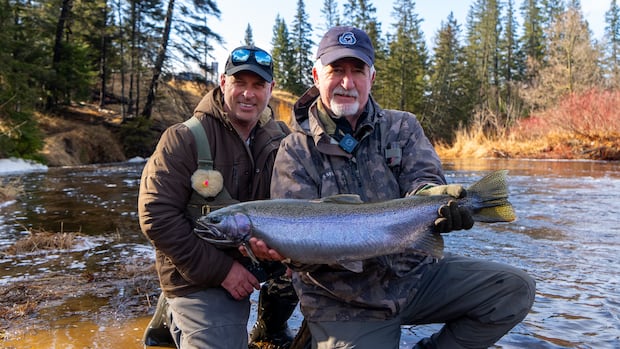Anglers are flocking to streams and rivers at the many urban fishing spots in Thunder Bay, Ont., as steelheads — also known as rainbow trout — have begun their spawning run.
Ben Gill, a Grade 10 Hammarskjold High School student, and his friends walk or bike to McVicker Creek, an urban creek in Port Arthur known for the spawning of steelhead, at least three times weekly.
“Most people don’t get to do this and it is really good opportunity,” said Ben, who was interviewed while fishing with his friend Angus Woodman recently. “It’s a good chance for me to get outside and do what I like.”
Typically fishing for an hour and a half before school, he explained they tend to harvest a couple of fish a year, but largely capture and release them to preserve the spot.
“I like to do catch and release just to keep the fish alive and keep the ecosystem in the river healthy,” said Ben. “And I want to be able to keep as many fish in the river as possible so that we can keep doing steelheading and so that there will be fish in the river for everyone else.”
Sustainable fishing in changing climate
Ben’s father, Ian Gill, also joined the fishing excursion before work. He agreed while they’re lucky to have several city waterways that allow a healthy steelhead population to spawn and locally harvest, it’s especially important with the changing climate to minimize harm to the fish.
“Things are changing and I’m not an ecologist or a biologist, but it’s pretty clear that populations are decreasing,” Ian said. “So I think that being mindful and recognizing that we’re stewards of these waterways, we need to keep them clean and we need to be sensitive to the fish that we’re so lucky to be able to catch.”
Steelheads, also known as rainbow trout, have started their spawning run in Thunder Bay, Ont., which means anglers are coming out of the woodwork with dreams of catching the big one. The CBC’s Gord Ellis met up with Randy Beamish, a long-time member of the North Shore Steelhead Association, to talk about efforts to keep urban fishing alive for generations to come.
The fishery in Lake Superior and the river systems in Thunder Bay have been managed well by Ontario’s Ministry of Natural Resources, but the worsening effects of climate change in the next 20 to 30 years could mean that changes to the fishery management need to happen as well, said Michael Rennie, a biology professer at Lakehead University and Canada Research Chair in freshwater ecology and fisheries.
Research from the IISD Experimental Lakes Area, for instance, indicates the open water season is already about three weeks longer than before and this could affect fish species, particularly cold-water fish, like lake trout.
Officials are staying vigilant about changing regulations to meet the needs of the fish, he said.
MacIntyre River another famous angler spot
Randy Beamish, a longtime member of the North Shore Steelhead Association (NSSA), is part of a mark and recapture study to provide a snapshot of fish populations living in the MacIntyre River to regulatory authorities. He said it is one of six fishable rivers within the city, also including:
- Kam River.
- Neebing River.
- McVicker Creek.
- Mckenzie River.
- Current River.
“The three major ones — the Neebing, Macintyre, and McVickers — they’re all accessible to almost anyone,” said Beamish. “The road’s right here. You don’t have to have a truck drive an hour out of town. You can bicycle here. A lot of the younger people do that or get dropped off by their parents.”
However, while it’s a blessing to have available, Beamish said these fish populations are highly susceptible to environmental and angling pressures, making it essential to avoid overharvesting.
“[Catch and release] is extremely important because unfortunately with a large size limit [27 inches], the potential when you keep that fish is that you’ve taken those genetics out of the system,” said Beamish. “And when you see the volatility of our springs and our seasons, these fish are highly susceptible.”
Although the NSSA will continue to keep its size rule in place to ensure residents “have a world class fishery in a large urban setting,” Beamish concluded that he does not want to dissuade fishing in the urban waterway.
“It’s really important that anglers understand that it is a high-quality world-class fishery,” said Beamish. “There are other rivers that don’t have that limit on them and you can go get a smaller fish to eat.”




